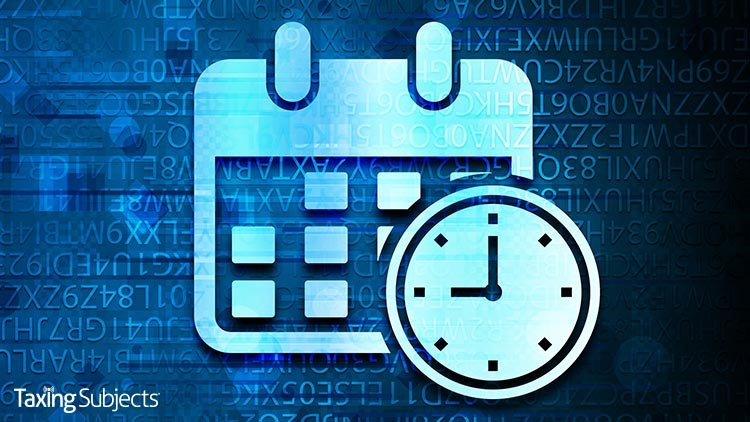by | May 29, 2021 | Tax Tips and News
The Internal Revenue Service is willing to stay the course on interest rates, announcing rates for the third quarter of 2021 will be just the same as the previous two quarters.
The Internal Revenue Code mandates the rate of interest to be determined on a quarterly basis—and the Q3 rates are here:
- 3% for individual overpayments
- 2% for corporate overpayments
- 5% for the portion of a corporate overpayment exceeding $10,000
- 3% for underpayments
- 5% for large corporate underpayments
Taxpayers who aren’t corporations have a simple calculation to figure the applicable rate of interest. Since those taxpayers’ overpayment and underpayment rates are the same, either rate will be the sum of the federal short-term interest rate plus 3 percentage points.
Corporations tend to have lower interest rates for overpayments—especially large ones—and large corporations have a higher rate for underpayments.
“Generally, in the case of a corporation, the underpayment rate is the federal short-term rate plus 3 percentage points and the overpayment rate is the federal short-term rate plus 2 percentage points,” the IRS explains. “The rate for large corporate underpayments is the federal short-term rate plus 5 percentage points. The rate on the portion of a corporate overpayment of tax exceeding $10,000 for a taxable period is the federal short-term rate plus one-half (0.5) of a percentage point.”
What separates the large corporation from the not-so-large corporation is spelled out in the instructions for Form 2220, Underpayment of Estimated Tax by Corporations:
“A large corporation is a corporation (other than an S corporation) that had, or whose predecessor had, taxable income of $1 million or more for any of the 3 tax years immediately preceding the 2020 tax year, or if less, the number of years the corporation has been in existence.”
The IRS will make these rates official with Revenue Ruling 2021-10, which will announce the rates of interest. The ruling is expected to be included in Internal Revenue Bulletin 2021-25, due out June 21.
Sources: Interest rates remain the same for the third quarter of 2021; Instructions for Form 2220, Underpayment of Estimated Tax by Corporations.
– Story provided by TaxingSubjects.com
by | May 26, 2021 | Tax Tips and News
Spring has sprung. Income tax filing season is over, and that means it’s time to get ready for the annual Virtual Nationwide Tax Forum. This year’s event will be held over five weeks, with live-streamed seminars three days each week.
The Nationwide Tax Forum is the IRS’ signature event, a summer tradition going back some 30 years. It targets the nation’s tax professionals, providing education and updates on a number of topics, such as tax law, cybersecurity, and ethics. In fact, registering and attending the Virtual Nationwide Tax Forum allows many tax pros to completely satisfy their annual requirements for continuing education.
While the Nationwide Tax Forum has historically been an in-person event, the IRS decided this year’s event would once again be held virtually—just as an extra measure of caution and to help ensure everyone’s safety.
How do I register for the 2021 Virtual Nationwide Tax Form?
The IRS says registration for the 2021 Virtual Nationwide Tax Forum is now open. Those who register by 5:00 p.m. EST on June 15 will qualify for the Early Bird rate of $240 per person. On June 16, registration reverts to the standard rate of $289 per person.
Everyone loves a discount …
Those lucky tax professionals who belong to one of the IRS’ partner organizations for the Tax Forum qualify for a $10 discount off the Early Bird registration price—but only if they register by the June 15 cutoff date. These partner groups include:
- American Bar Association (ABA) Section of Taxation
- American Institute of Certified Public Accountants (AICPA)
- National Association of Enrolled Agents (NAEA)
- National Association of Tax Professionals (NATP)
- National Society of Accountants (NSA)
- National Society of Tax Professionals (NSTP)
- Low Income Taxpayer Clinics (LITC)
- Volunteer Income Tax Assistance Program (VITA)
The IRS says members of these groups should contact their respective associations directly for more information.
This year’s highlights …
The 2021 event starts on July 20 and continues through August 19. During that time, webinars will be live-streamed on Tuesdays, Wednesdays, and Thursdays. Registration enables a tax pro to take part in every one of the live webinars and earn up to 28 continuing education credits.
Internal Revenue Service Commissioner Chuck Rettig will kick off the Tax Forum, delivering the traditional keynote address. Commissioner Rettig will be followed by a plenary session that spotlights changes to tax law and publication updates.
Later, multiple sessions will zero-in on a wide spectrum of topics including virtual currencies, the gig economy, the new Advance Child Tax Credit, advanced cybersecurity, professional ethics and more. Presenters will include IRS experts and those from tax partner groups.
For the first time, the plenary session and an ethics webinar will be available in both English and in Spanish. Attendees in the Virtual Expo will also have access to additional multilingual sources.
Details about courses—including webinar titles, descriptions and a course schedule—are now available.
Connect with the Virtual Expo
Registration for the 2021 Virtual Nationwide Tax Forum includes access to the Virtual Expo. The Expo is where exhibitors from dozens of leading companies throughout the tax industry show off the latest and greatest in hardware, software, services and more. Industry professional organizations and key IRS offices also are represented in the Expo.
The IRS multilingual engagement and services booth is new for 2021, and has expanded resources, IRS publications, forms, and webpages now available in multiple languages. IRS exhibitors will also share some news about upcoming multilingual projects.
The agency also lists the following highlights:
- The latest tax products and software
- The IRS Zone and engagement with representatives from IRS program offices
- Bonus Q&A sessions in the Speaker’s Corner
- Live webinars from many of [the IRS’s] sponsors
Those attendees who would like to share their opinions directly with the IRS will get their chance at the 2021 Virtual Nationwide Tax Forum. The agency will assemble small, virtual focus groups to share their experiences and talk over creative ideas directly with IRS experts and others. Check the Tax Forum website for topics and the qualifying criteria for the focus groups.
Come see us at the IRS Virtual Expo!
Don’t forget to check out the Drake Software virtual booth during the IRS Virtual Nationwide Tax Forum!
Source: IR-2021-118
– Story provided by TaxingSubjects.com
by | May 25, 2021 | Tax Tips and News
The loss of health insurance is a major concern for the millions of Americans who have filed for unemployment throughout the pandemic. While COBRA continuation coverage can help bridge the gap between jobs, former employers generally are not required to pay part of the premiums—meaning some beneficiaries have to foot the entire bill for their insurance.
Congress sought to address this issue with a provision in the American Rescue Plan Act of 2021 (ARP) that provides COBRA premium assistance and provider-related tax credits. As with any other major legislation affecting taxes, that meant the Internal Revenue Service had to determine the best way to administer those provisions.
Last week, the agency announced the publication of Notice 2021-31, which includes “guidance for employers, plan administrators, and health insurers regarding the new credit available to them for providing continuation health coverage to certain individuals under COBRA.”
How does the American Rescue Plan Act affect COBRA continuation coverage?
“The American Rescue Plan provides a temporary 100 percent reduction in the premium that individuals would have to pay when they elect COBRA continuation health coverage following a reduction in hours or an involuntary termination of employment,” the IRS explains. “The new law provides a corresponding tax credit for the entities that maintain group health plans, such as employers, multiemployer plans, and insurers.”
While COBRA is a federal plan that affects most employers with 20 or more full-time employees, the IRS notes that some states have their own version of continuation coverage. Employees receiving benefits from what the IRS calls “state ‘mini-COBRA’” plans are also eligible to receive premium assistance.
How long will the COBRA premium assistance last?
The IRS says ARP will provide COBRA premium assistance for “Assistance Eligible [Individuals]” from April 1, 2021 to September 30, 2021 (1). However, “premium assistance is not available if an individual is eligible for coverage under any other group health plan or for Medicare” (2).
What else is included in Notice 2021-31?
Notice 2021-31 includes a nearly 40-page question-and-answer section that covers the following COBRA premium assistance topics:
- Eligibility for COBRA Premium Assistance
- Reduction in Hours
- Involuntary Termination of Employment
- Coverage Eligible for COBRA Premium Assistance
- Beginning of COBRA Premium Assistance Period
- End of COBRA Premium Assistance Period
- Extended Election Period
- Extensions Under the Emergency Relief Notices
- Payments to Insurers Under Federal COBRA
- Comparable State Continuation Coverage
- Calculation of COBRA Premium Assistance Credit
- Claiming the COBRA Premium Assistance Credit
To learn more, check out the links below.
Sources: IR-2021-115; Notice 2021-31
– Story provided by TaxingSubjects.com
by | May 22, 2021 | Tax Tips and News
The deadline for filing income taxes came and went on May 17, but that’s no reason to think the filing door is completely shut.
Taxpayers who owe tax due but didn’t request an extension should file now to keep their penalties and interest to a minimum. Even if taxpayers don’t owe tax due, it’s still in their best interests to file sooner rather than later.
No file, no refund …
Taxpayers don’t face a penalty for filing after the deadline if they’re due a refund. But they can’t get their refund if they don’t file. For those who missed the filing deadline, it’s best to file as soon after the deadline as possible.
E-filing through a trusted tax professional is a fast, efficient way to get it done.
If a taxpayer expects to owe tax due, another set of considerations come into play.
In a perfect world, taxpayers should file a tax return or ask for an extension, and pay any tax they owe by the deadline, avoiding penalties and interest.
Getting an extension to file, of course, has no bearing on any tax due; that’s still due by the tax deadline. In this case, it was May 17. So, penalties and interest now apply, and only get more expensive as more time goes by.
So, by filing now, those taxpayers will wind up paying less in penalties and interest. the IRS has helpful information for taxpayers who owe the IRS, but can’t afford to pay.
Time is money
The IRS ordinarily charges 5 percent of the tax owed for each month—or part of a month—that a tax return is late. This formula is used for filing up to five months after the due date. The total penalty, the IRS says, will be reduced by the amount of the failure-to-pay penalty for any month where failure-to-file and failure-to-pay penalties both apply.
Wait more than 60 days to file and pay, though, and things go from bad to worse. The minimum penalty is either $435 or 100 percent of the unpaid tax, whichever is less.
The penalties stack up quickly so it’s important to file and pay as much as possible—as soon as possible—even if the taxpayer can’t pay the entire tax bill at once.
The government’s penalty rate for failure to pay is generally 0.5percent of the unpaid tax that’s owed for each month or part of a month until the tax is fully paid or until the taxpayer has paid 25percent of the tax due.
Interest is charged on tax and penalties until the balance is paid in full.
The interest rate is updated regularly, so it’s subject to change.
IRS.gov/penalties has more information about how penalties are assessed.
A taxpayer’s history can make a difference when it comes to penalties. The IRS says those who have a history of filing and paying on time often qualify for penalty relief. Usually, taxpayers can qualify if they’ve filed and paid on time for the previous three years and met other requirements.
The first-time penalty abatement page on IRS.gov has more information on how to qualify.
Some still have time
The IRS also points that some taxpayers still have time to file, even if they didn’t file an extension:
Taxpayers who filed paper returns may have delays in seeing their returns processed, since the IRS processes paper returns in the order they are receive—and the agency says COVID-19 is still causing delays. That said, those who already filed a paper return should not file a second return or call the IRS to try to skip the line.
As for just how long it takes to get the refund, ninety percent are sent within 21 days. But returns that need “additional review” obviously take longer.
Pay as soon as possible to avoid penalties and interest
Taxpayers who owe tax due should consider paying what they can now. The fastest way to pay is through IRS Direct Pay, with a debit or credit card, or to apply online for an IRS payment plan (including an installment agreement).
Source: With the May 17 deadline in the past, file taxes now to get refund or cut penalties and interest
– Story provided by TaxingSubjects.com
by | May 20, 2021 | Tax Tips and News
A provision of the American Rescue Plan is being readied for action, targeting nearly 90 percent of American households with children to receive monthly payments of the Child Tax Credit.
The Internal Revenue Service and the Department of the Treasury expect to send out the first monthly payments of the expanded Child Tax Credit (CTC) on July 19.
Payments are targeted to some 39 million households, which would cover 88% of the children in the U.S.
How will it work?
Monthly payouts for the Child Tax Credit were made possible by the American Rescue Plan that was passed into law in March of this year. The law increased the maximum cap to $3,600 for children under age 6 and up to $3,000 per child for those between age 6 and 17.
The ARP also made the credit advanceable, enabling regular payments to qualified families.
The recurring CTC payments will be made on the 15th of each month, unless the 15th is a weekend or holiday. Those families who get the credit via direct deposit will be able to plan around the regular receipt of the payment.
Qualifying families receive a payment of up to $300 per month for each child under age 6 and up to $250 per month for each child age 6 and up.
Projections suggest the plans for the CTC could cut child poverty by more than half.
Direct deposit is the way to go
The monthly payments will go out to families – benefiting more than 65 million children—by way of direct deposit, paper check or debit cards.
The IRS says it’s committed to making the most of the direct deposit delivery option for fast, secure delivery.
Most taxpayers won’t have to take any action to get advance CTC payments. However, the IRS and Treasury say they’ll continue to work with partner groups to make even more families aware of the benefit.
An IRS press release on the CTC payouts credits the project to teamwork among four governmental bodies: the IRS, the Department of the Treasury, the Bureau of the Fiscal Service and the White House American Rescue Plan Implementation Team.
More information on how taxpayers can access the Child Tax Credit will be available soon at IRS.gov/childtaxcredit2021.
– Story provided by TaxingSubjects.com
by | May 18, 2021 | Tax Tips and News
Some individual taxpayers and businesses in certain Tennessee counties have gotten some good news for a change: They have until August 2 to file their various tax returns with the IRS.
These taxpayers have had their share of bad news lately, mostly due to spring storms, flooding and tornadoes that ravaged the state on March 25 and again on April 3.
Who gets relief?
The Internal Revenue Service granted the relief package based on the counties that have been declared federal disaster areas in Tennessee by the Federal Emergency Management Agency (FEMA). This makes the relief benefits available to individuals and businesses with addresses on record in the following counties:
- Campbell
- Cannon
- Cheatham
- Claiborne
- Clay
- Davidson
- Decatur
- Fentress
- Grainger
- Hardeman
- Henderson
- Hickman
- Jackson
- Madison
- Maury
- McNairy
- Moore
- Overton
- Scott
- Smith
- Wayne
- Williamson
- Wilson
This list may expand over time, as new counties and communities are declared federal disaster areas. For a current list of eligible locations, check out the disaster relief page on IRS.gov.
What’s included?
The relief package takes various tax filing and payment deadlines that would have occurred any time since March 25 and pushes them back, giving affected individuals and businesses until August 2 to file their taxes and pay any tax due.
Deadlines that fall under the postponement include 2020 individual income tax returns normally due May 17, various 2020 business returns normally due April 15, and the deadline for 2020 IRA contributions.
Also delayed: quarterly estimated income tax payments due April 15 and June 15, quarterly payroll and excise tax returns due on April 30, and tax-exempt calendar-year returns normally due May 17.
The IRS says it will abate any penalties on payroll and excise tax deposits due on or after March 25 and before April 9, as long as the deposits are made by April 9.
Remember, relief measures are granted automatically; there’s no need to contact the IRS to apply. Whenever an affected taxpayer files, the IRS checks the address of record during processing and applies the relief.
Those who live outside a disaster area but have records needed for filing located within the disaster area should call the IRS at 866.562.5227. Workers helping with disaster relief efforts in the affected counties who are affiliated with a recognized government or philanthropic organization should also call the number.
The tax relief covers six states
The relief measures for Tennessee counties is the latest package set in motion by the IRS. It joins previously announced measures in five other southern states:
- Individuals and businesses in Texas, Oklahoma, and Louisiana have until June 15 to file and pay. All taxpayers in these three states qualify for relief.
- Individuals and businesses in parts of Kentucky have until June 30 to file and pay.
- Individuals and businesses in parts of Alabama have until August 2 to file and pay.
Filers, whether individual taxpayers or businesses, have the option to claim their uninsured or unreimbursed disaster losses either on the return for the year the loss occurred (such as the 2021 return to be filed next year), or the return for the prior year.
For any return that claims a loss, write the FEMA disaster declaration number – in this case, 4601DR – on the return before it’s filed. Publication 547 has more information on the process.
If affected taxpayers in the disaster areas need an extra extension beyond the relief given, they can submit a request for an automatic extension, pushing their filing deadline back to October 15. The IRS reminds, however, that an additional extension applies only to filing; payment will be due on the date specified in the relief measures.
Source: IRS extends May 17, other tax deadlines for victims of Tennessee storms
– Story provided by TaxingSubjects.com






